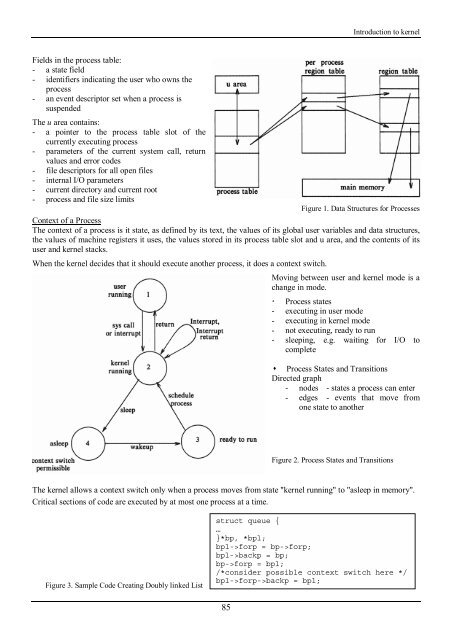Create successful ePaper yourself
Turn your PDF publications into a flip-book with our unique Google optimized e-Paper software.
Introduction to kernel<br />
Fields in <strong>the</strong> process table:<br />
- a state field<br />
- identifiers indicating <strong>the</strong> user who owns <strong>the</strong><br />
process<br />
- an event descriptor set when a process is<br />
suspended<br />
The u area contains:<br />
- a pointer to <strong>the</strong> process table slot of <strong>the</strong><br />
currently executing process<br />
- parameters of <strong>the</strong> current system call, return<br />
values and error codes<br />
- file descriptors for all open files<br />
- internal I/O parameters<br />
- current directory and current root<br />
- process and file size limits<br />
Figure 1. Data Structures for Processes<br />
Context of a Process<br />
The context of a process is it state, as defined by its text, <strong>the</strong> values of its global user variables and data structures,<br />
<strong>the</strong> values of machine registers it uses, <strong>the</strong> values stored in its process table slot and u area, and <strong>the</strong> contents of its<br />
user and kernel stacks.<br />
When <strong>the</strong> kernel decides that it should execute ano<strong>the</strong>r process, it does a context switch.<br />
Moving between user and kernel mode is a<br />
change in mode.<br />
! Process states<br />
- executing in user mode<br />
- executing in kernel mode<br />
- not executing, ready to run<br />
- sleeping, e.g. waiting for I/O to<br />
complete<br />
" Process States and Transitions<br />
Directed graph<br />
- nodes - states a process can enter<br />
- edges - events that move from<br />
one state to ano<strong>the</strong>r<br />
Figure 2. Process States and Transitions<br />
The kernel allows a context switch only when a process moves from state "kernel running" to "asleep in memory".<br />
Critical sections of code are executed by at most one process at a time.<br />
Figure 3. Sample Code Creating Doubly linked List<br />
struct queue {<br />
…<br />
}*bp, *bpl;<br />
bpl->forp = bp->forp;<br />
bpl->backp = bp;<br />
bp->forp = bpl;<br />
/*consider possible context switch here */<br />
bpl->forp->backp = bpl;<br />
85
















